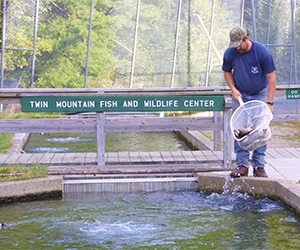New Hampshire Fish Hatcheries
Information and Locations of NH Trout and Salmon Hatcheries
The New Hampshire Fish and Game Department is undertaking a project to modernize its hatchery system. The oldest facilities (4 of them) are over 100 years old and the newest is just over 50 years old. See details on the Hatchery Modernization Project.
The NH Fish and Game Department uses fish culture (raising fish in a controlled environment) and stocking as a strategy to achieve two goals:
- To ensure that New Hampshire has abundant species of trout and salmon at sustainable levels.
- To ensure that New Hampshire has trout and salmon populations that support the desired levels of fishing.
The mission of the fish hatchery system is to produce fish of the right species, size, and timing to fill the gaps in the natural ecosystem to contribute to management goals for a wide variety of users and restoration of self-sustaining native fish populations. Fisheries managers use cultured fish as a tool to achieve desired fisheries or restore self-sustaining fish populations, which would not otherwise be possible for various reasons. Fish culture is used only where needed to meet management goals and fish culturists strive to efficiently raise fish that best meet the needs of anglers and of fisheries management programs.
 The use of fish culture is vitally needed to achieve satisfactory trout and salmon fisheries in New Hampshire. Without hatcheries, it is estimated trout and salmon populations in New Hampshire waters would be depleted in approximately 3-5 years, due primarily to fishing pressure. This is because the capacity of New Hampshire's waters for trout production is about 10 pounds per acre, due to the granite substrate material and lack of fertility (some states have waters with more fertility and dissolved minerals capable of producing 300 pounds of trout per acre or greater). While there are relatively few fish species in New Hampshire that require the help of fish culture, they are among some of the most popular with anglers. They include brook trout, rainbow trout, brown trout and landlocked salmon.
The use of fish culture is vitally needed to achieve satisfactory trout and salmon fisheries in New Hampshire. Without hatcheries, it is estimated trout and salmon populations in New Hampshire waters would be depleted in approximately 3-5 years, due primarily to fishing pressure. This is because the capacity of New Hampshire's waters for trout production is about 10 pounds per acre, due to the granite substrate material and lack of fertility (some states have waters with more fertility and dissolved minerals capable of producing 300 pounds of trout per acre or greater). While there are relatively few fish species in New Hampshire that require the help of fish culture, they are among some of the most popular with anglers. They include brook trout, rainbow trout, brown trout and landlocked salmon.
The Fish and Game Department currently stocks 1,473 miles of streams (approximately 13 percent of the state's 10,881 miles of rivers and streams) and 375 lakes and ponds (approximately 22 percent of the state's 1,708 lakes and ponds). To do this, we produce and distribute 200 or more tons of trout and salmon per year. The majority of our fish production, as measured by weight, consists of catchable size trout, which are used for put-and-take management. In comparison, the majority of our fish production, as measured by numbers, consists of fry or fingerling salmon or trout, which are used for restoration or put-grow-and-take management.



